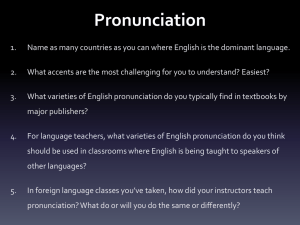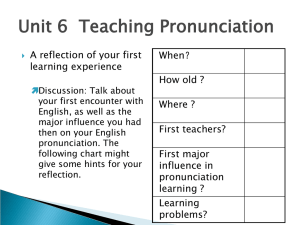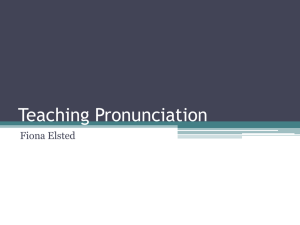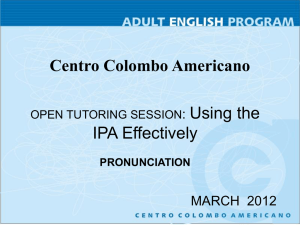PowerPoint 演示文稿
advertisement
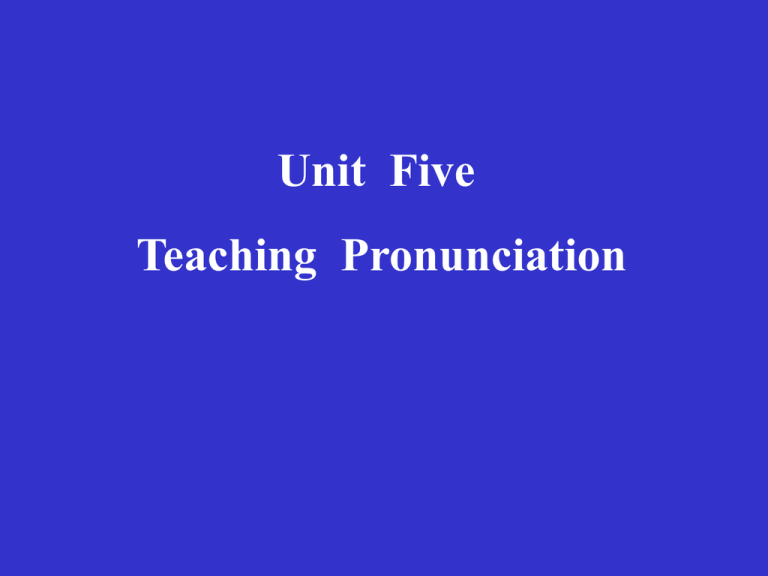
Unit Five Teaching Pronunciation Pronunciation Questionnaire 1. Do you think that it is important to speak with good pronunciation? Why or why not? 2. Do you think it is important for you to teach pronunciation in your classes? Why or why not? 3. In what situations would it be particularly useful or perhaps necessary to speak with good pronunciation? 4. Do you think that pronunciation will be interesting/important to your students? 5.How do you plan on teaching pronunciation to your students? 6. For you, which is more important, that your students have a good pronunciation or that they communicate effectively? Explain. I. The Role of Pronunciation There exist two points of view: Some people claim that students do not need to learn pronunciation because pronunciation will take care of itself as the students develop overall language ability. Some people think that failure in pronunciation is a great obstacle in language learning. The teaching of pronunciation should focus on the students’ ability to identify and produce English sounds themselves. Phonetic rules are helpful for students to develop the ability to cope with English pronunciation and they should be introduced at a suitable stage. Stress and intonation are as important as the sounds themselves and should be taught from the very beginning, for different intonation can create different meanings. II. The goal of teaching pronunciation It is true that language students’ pronunciation should be as good as possible. The learners of English as a foreign language cannot achieve native-like pronunciation, except those who start learning English at a very young age. The Critical Period Hypothesis: if human don’t learn a foreign language before a certain age, then due to changes such as maturation of the brain, it becomes impossible to learn the foreign language like a native speaker. This is true for acquiring native-like pronunciation, but there is less evidence that it is true for acquiring the grammar or the vocabulary of a foreign language. Everyone agrees that all people who learn a foreign language after puberty will always have an accent. It will be easy for the native-speaker to identify that the person is not a native-speaker of that language. The amount of exposure to English is another factor that determines if the students can acquire native-like English pronunciation. And due to the biological and physiological differences, individual students have different phonetic ability. It is not realistic for the majority of students to have a native-like English pronunciation. Our realistic goals of teaching pronunciation should be: Consistency: The pronunciation should be smooth and natural. 1) Intelligibility: The pronunciation should be understandable to the listeners. Communicative efficiency: The pronunciation should help to convey the meaning that is intended by the speaker. When trying to achieve consistency in pronunciation, students should not sacrifice intelligibility. Unintelligible speech is useless and may cause unpleasant feelings for the both speaker and the audience. But consistency and intelligibility are not enough in real communication. Students should pay attention to intonation. Different intonation can convey different meaning. 1 1) III. Aspects of pronunciation The pronunciation of a word or syllable with more force than the surrounding words or syllables. Syllables can be stressed or unstressed. A listener hears a stressed syllable or word as being louder / of longer duration / or produced with higher pitch then the surrounding word or syllables. A syllable may be stressed because: Stress: ( 1 ) the accent is on that syllable. ( 2 ) the speaker wants to emphasize that syllable. Intonation: When speaking people general raise or lower the pitch of the voice, forming pitch pattern. They also give some syllables in their utterances a greater degree of loudness and change their speech rhythm. These phenomena are called intonation. Intonation has definite patterns which can be analyze according to their structure and functions. Intonation patterns may have: 1) It has grammatical functions, they can show that an utterance is a question and not a statement. ( 2 ) give additional information to that given by the words of an utterance. I GOT the job. ( it was doubtful whether I could.) ( 3 ) indicate the speaker’s attitude to the matter discussed or to the listener. But I TOLD you. Rhythm: Rhythm in speech is created by the contracting and relaxing of chest muscle ( pulses). This causes changes air pressure. Students should pay attention to stress and intonation. Research has showed that when a native speaker mishear something, it is because the foreigner has put the stress on the wrong place, but because she/ he has mispronounced the sounds of the words. Language learning needs of practice and it is true with pronunciation. There are two kinds of practices: Practice is necessary for the development of many skills, for example, typing. Meaningful practice is more desirable. Everything can be learned more effectively if it is meaningful. IV. Practising sounds 1) Focusing on a sound When teaching pronunciation, we need to focus on individual sounds, especially those difficult to learn. The following are some common approaches to the teaching of pronunciation for the Chinese teachers: There are two different patterns of pulses: (1) a more regular type of contraction with regular rises in air pressure ( chest pulses) (2) less frequent but stronger contractions with more sudden rises in air pressure ( stress pulses ) two systems operate together in any one language is said to cause different types of speech rhythm. Explain how to make the sound: we suggest this can be done at later stage because if the students can produce the sound correctly after the teachers’ modeling, it is not necessary to explain HOW. When students have difficulty producing the sound, explanations will do. Contrast with other sounds: This can also be done at later stage when the students have obtained a certain degree of mastery of the sound. Write words on the board: it is unnecessary because words written on the board will distract students’ attention from the teacher’s modeling. And they will try to produce the sounds of the words they see and neglect what the teacher says. 2) Perception practice: Perception practice is aimed at developing the students’ ability to identify and distinguish between different sounds. Correct perception of sounds is vital for listening comprehension. We have the following methods to practise. (1) Using minimal pairs: Minimal pairs are two words which have only one different sounds. The teacher reads either word of each pair and asks the students to tell which one is read. which order: The teacher reads each group of words in a different order and the students mark the words with 1, 2, 3, to indicate the order in which the words are read. The teacher can read the words several times in different order. ( 3 ). Same or different: The teacher reads pairs of words and ask the students to tell if the air of words are the same or different. The words should not be written out. 4 ) Odd man out: The teacher reads a group of words a time and the students identify the different word or sound. The words are not written out. 5 ) Completion: the teacher reads a series of words which have only one different sound. The students complete the words they hear. Production practice: Production practice is aimed at developing students’ ability to produce sounds. Producing distinct and understandable sounds is very important for effective Communication. Production practice of pronunciation varies from mechanical imitation to production in meaningful context. A few types of activities are: Listen and repeat: The students repeat what the teacher says. This activity can be used to practise individual sounds, individual words, groups of words and sentences. Fill in the blanks: The students fill in blanks in sentences with words which contain certain sounds. Make up sentences: The students are given a group of words containing the same sound or similar sounds. They should make up sentences using as many of the given words as possible. The sentences do not have to realistically meaningful and logical. Humorous sentences are preferred. Using meaningful context: The sounds to focus on are embedded in a meaningful context and students perform meaning tasks while “ keeping an eye on” the sounds. Using pictures: The students produce meaningful language based on the pictures. The students perform meaningful tasks while keep an eye on particular sounds. Use tongue twisters: tongue twisters are often used in pronunciation practice because they fun and motivating. Also the relaxing atmosphere helps students to overcome inhibition. Students should be given time to practise on their own for a few minutes before they are asked to perform in front of the class. Practising stress and intonation There are two kinds of stress that are important in achieving good pronunciation. word-level stress: it is very important to stress the proper syllable in multi-syllabic words. If the wrong syllable is stressed, listeners will not understand what word is being pronounced. So the best strategy is to emphasize the importance of learning the stress as part of learning a word. phrase-level stress: each phrase has one syllable which receives greater or more prominent stress than the others. Some phrases have only one stressed syllable, while others may have 5—6 stressed syllables. And the best way is to make the students be aware of where to stress the word or phrase. Teachers can use the following ways to show the stress pattern of words, phrases and sentences. ( a ) Use gestures. The teacher can indicate the stress by clapping hands or using arm movements as if conducting music. ( b ) Use the voice. The teacher can raise the voice to indicate stress. This can be done with some exaggeration sometimes. ( c ) Use the blackboard. The teacher can highlight the stresses by underlining them or writing them with coloured chalks or in different size. Practicing intonation Intonation can greatly affect the intention of the speaker’s message. Intonation can be used to express meanings such as surprise, complaint,sarcasm, friendliness, threat, etc. this is one of the last areas of language that foreign language learners can master and is also difficult to teach. Below are some further suggestions on teaching pronunciation: Use individual, pair, group and whole class practice formats to create a pleasant, relaxed and dynamic classroom. Use hands and arms to conduct choral pronunciation practice. Move around the classroom while doing choral practice Vary the criteria of good in pronunciation practice to give students confidence. It is helpful articulation practice more than once. Bring variety to the classroom. The main criteria of good pronunciation are consistency, intelligibility , and communicative efficiency. Do not rely on explanations. Make full use of demonstration. Try to use visual aids.
